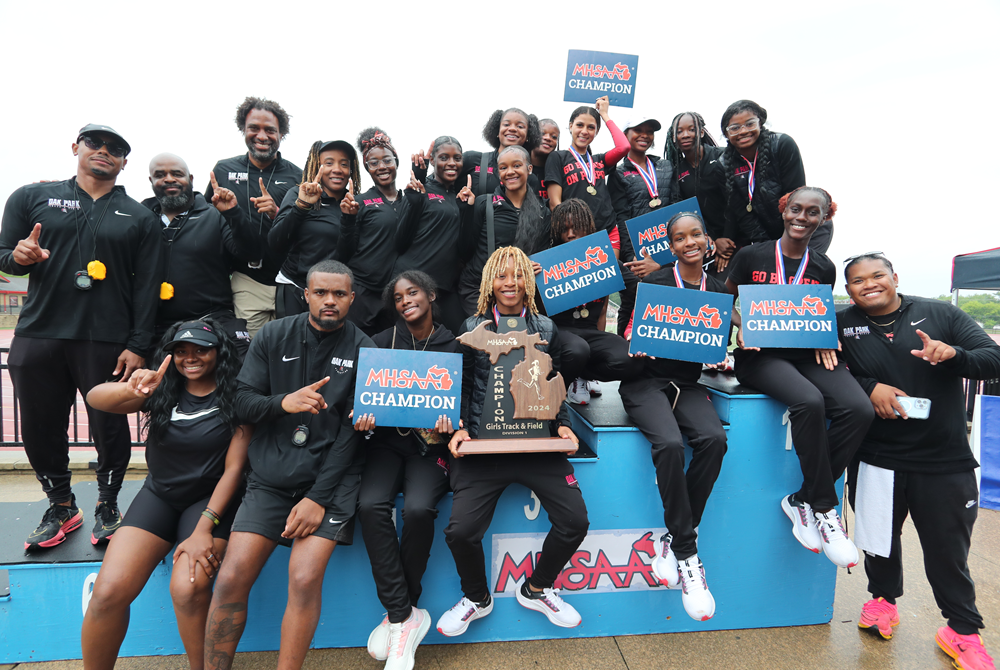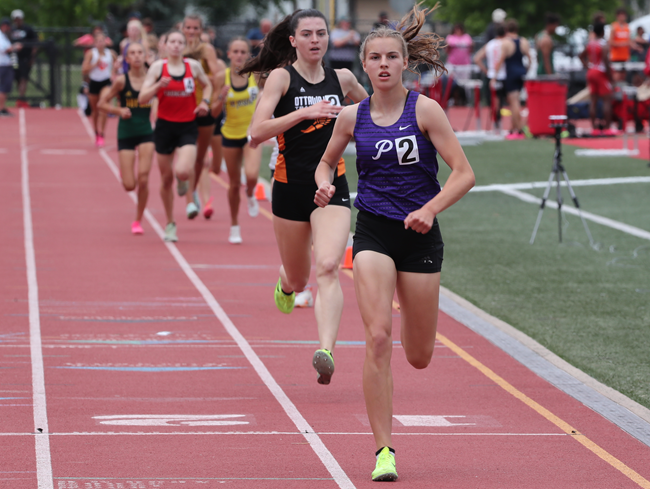
Classes Still Create Hoosier Hysteria
July 27, 2017
By Rob Kaminski
MHSAA benchmarks editor
This is the fourth part in a series on MHSAA tournament classification, past and present, that will be published over the next two weeks. This series originally ran in this spring's edition of MHSAA benchmarks.
Twenty years ago, Bloomington North High School won the Indiana High School Athletic Association boys basketball championship, defeating Delta 75-54 at the RCA Dome in Indianapolis.
The date, March 22, 1997, is at the same time revered and disdained by traditionalists in the state who saw it as the last schoolboy championship game the state would ever host.
That’s how devout the game of basketball, particularly interscholastic basketball, had become in the Hoosier state during the 87 years a state champion – one state champion, to be precise – was crowned.
Following that 1997 season, the IHSAA moved to a four-class system for its roundball tournaments, like so many of its state association counterparts had done years earlier.
It would be shocking to find more than a small percentage of current high school basketball players around the country unfamiliar with the iconic movie Hoosiers, even though the film is now more than 30 years old.
And, the storyline for that blockbuster unfolded more than 30 years prior to its release, when small-town, undermanned Milan High School defeated Muncie Central High School 32-30 in the 1954 IHSAA title game.
Perhaps it’s because of the David vs Goliath notion, or the fame of the movie that replaced Milan with the fictional Hickory and real-life star Bobby Plump with Hollywood hero Jimmy Chitwood, or the simple fact that Indiana had something other states didn’t.
Whatever the reason, plenty of opposition remains to this day to basketball classification in the state.
The fact is, the small rural schools were regularly being beaten handily by the much larger suburban and city schools as the tournament progressed each season.
Small schools also were closing at a rapid rate following the state’s School Reorganization Act in 1959, as students converged on larger, centralized county schools. From 1960 to 2000, the number of schools entering the tournament dropped from 694 to 381, and in 1997 a total of 382 schools and 4,584 athletes began competition at the Sectional level (the first level of the IHSAA Basketball Tournament).
It was at the entry level of the tournament where school administrators felt the pain of the new class system, but not necessarily for the same nostalgic reasons as the fans who either attended or boycotted the tournament.
At the Sectional round of the tournament, the IHSAA was culling just 2 percent of the revenue, with the participating schools splitting the balance. So, when Sectional attendance dropped by 14 percent in that first year of class basketball, many schools realized a financial loss. It was money they had grown to count on in prior years to help fund various aspects of the department.
Schools cumulatively received more than $900,000 from Sectional competition in 1998, but that total was down from more than $1 million in the last year of the single-class tournament.
Yet, the current format provides a great deal more opportunity and realistic chances at championship runs for schools of all enrollments.
To date, 60 additional teams have championship or runner-up trophies on display in school trophy cases around Indiana.
That was the mission in front of then-IHSAA commissioner Bob Gardner (now National Federation executive director) once the board made its decision: to give thousands more student-athletes the opportunity for once-in-a-lifetime experiences.
As any statistician knows, figures can be manipulated to tell any side of a story. Declining attendance in year one of class basketball is such a number.
The truth is tournament attendance had been on a steady downward spiral since its peak of just over 1.5 million in 1962. By the last single-class event in 1997, the total attendance was half that.
The challenge then and today, as it is for all state associations, is to find that delicate balance for those holding onto tradition, those holding onto trophies, and the number of trophies to hand out.
Editor’s Note: Stories from the Fort Wayne Journal Gazette in 1998 and from a 2007 issue of Indianapolis Monthly provided facts in this article.

Oak Park, Returning Individual Champs Lead Chase Again at Star-Filled Finals
By
Steve Vedder
Special for MHSAA.com
June 1, 2024
Abby Russell has no problem throwing as the favorite with everyone else hoping to catch her.
In fact, the Allen Park senior embraces summoning up her best efforts in both the discus and shot put every time she lines up to throw. Russell said she's never equated success with the pressure of being a state champion.
"To be honest, no," said Russell, who closed out a stellar career by winning those two events at Saturday's Lower Peninsula Division 1 Finals at East Kentwood. "I just focus on myself. Going to see a sports psychologist has helped me a lot with that. We talk about the work you have to put in, and (success) being a consistency thing."
Whether it's pure talent or seeking professional guidance or the ability to deal with pressure, Russell finished off an outstanding career in winning the discus (156-6) and the shot (46-10) on Saturday. The two titles are added to a first as a sophomore and third as a junior in the shot. She's now a three-time champ in the discus.
The wins at East Kentwood were also personally rewarding to Russell, who didn't place in the shot as a freshman at Falcon Stadium. It's one of the few places where the University of Michigan-bound Russell figures she could have done better.
"I was real bad as a freshman, so I was happy to get back here again," she said. "I had a great time back then. I just didn't do what I wanted."
While Russell was among those dominating the individual meet Saturday, Oak Park was sweeping its way to a team title. The Knights finished with 88 points to easily outdistance runner-up Ann Arbor Pioneer's 42. Detroit Renaissance was third with 35 points, East Kentwood was fourth with 34 and Saginaw Heritage had 30.
Oak Park coach Brandon Jiles, whose team collected its eighth Finals title under his leadership, said he wasn't sure what type of showing a young team would make Saturday. Of the 35 athletes on the roster, just three are seniors.
Still, Jiles thought the team would be in the hunt along with Pioneer, Renaissance and Detroit Cass Tech. At least part of the success was winning the 800 (1:38.10), 400 (47.53) and 1,600 (3:47.99) relays. The other firsts were by senior Morgan Roundtree in the 300 hurdles (41.31), freshman Nevaeh Burns in the 400 (55.02) and senior Kylee King (2:10.53) in the 800.
 "We thought we had a shot. We just take it one event at a time and do what we have to do. We only have three seniors, but they're really good kids. We'll have some good girls back next year, and they know they'll have to step up and score," Jiles said.
"We thought we had a shot. We just take it one event at a time and do what we have to do. We only have three seniors, but they're really good kids. We'll have some good girls back next year, and they know they'll have to step up and score," Jiles said.
"I'm a very competitive person when I see other teams that are good. I think the girls are like that too. We're ready when it comes to championship time."
Roundtree said her two chief goals at the meet were accomplished. She wanted to join a long list of successful Oak Park sprinters while also leading a young team to a championship.
"I want to motivate my teammates, and I think I was able to do that," said Roundtree, whose 300 time is ninth best in the country. "We've had some good sprinters here, and I really wanted to become one of them."
Among the other champions was Lena Cleveland of Rochester, who went from finishing fourth in the long jump a year ago to winning (18-2) that event Saturday. Cleveland is a former sprinter who traded the 100 and 200 for the long jump a couple of years ago.
"I wanted to try the long jump, and it's worked out," she said. "I put in a lot of hard work over the summer and in indoor. I also worked hard in strength training in the gym. I didn't used to have access to a (long jump) pit, but I was able to put in the work."
Rachel Forsyth of Ann Arbor Pioneer won the 1,600 (4:38.28) and 3,200 (10:15.57) to cap an outstanding four-year career. A two-time cross country Finals champ, Forsyth overcame illness to win the 1,600 a year ago. She was coming off a trip to the Trial of Miles meet in New York a couple of weeks ago, but said the Finals featured virtually no mental letdown.
"Maybe a little, but you can't control it," she said. "You can only control what you're doing that day. And I think I ran well. It was great because my sister was in the same three events I was in in 2017."
The other champions Saturday were Kamryn Tatum of West Bloomfield in the 200 (24.63), Brooke Bowers of Grand Rapids Forest Hills Central in the pole vault (12-9), Madison Morson of Salem in the high jump (5-10), Maya Rollins of Ann Arbor Pioneer (13.86) in the 100 hurdles, Willow Mason of Saginaw Heritage in the 200 (24.66) and Keyanna O'Tey of Sturgis in the 100 (12.08). West Ottawa won the 3,200 relay (9:00.27), and Fenton sophomore Molly Katic (100), Clarkston freshman Allison Thurman (200) and Sturgis freshman Vivian Massey (shot put) were the adaptive event champions.
PHOTOS (Top) Oak Park celebrates its latest LP Division 1 team championship Saturday at East Kentwood. (Middle) Ann Arbor Pioneer’s Rachel Forsyth leads the pack in the 1,600. (Click for more from John Brabbs/RunMichigan.com.)

